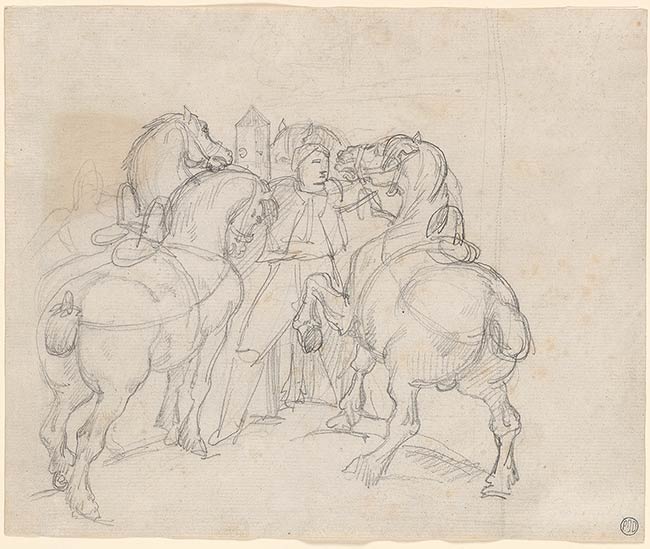
The horse became ubiquitous in Romantic art, and equine themes held particular significance for Géricault. He frequented equestrian events in Paris, briefly studied with Carle Vernet, a painter celebrated for his depictions of cavalry, and on his initial trip to Rome in 1816-17, he extensively studied the animal as he worked on his first major project there, "The Barberi Race" (Race of the Riderless Horses). The horse also figured substantively in the artist's life: already in precarious health, injuries from a riding accident contributed to Géricault's death at age thirty-two.
This study is preliminary to a watercolor in the Louvre depicting three grooms corralling five horses at a stake, which is justly celebrated for its masterful composition (Le marché aux chevaux; RF 1457). Though it is based on observations made during his Italian sojourn, the sheet was likely executed after the artist returned to Paris in late 1817. In this initial idea for the scene Géricault explored a more condensed and compact composition in which a trio of horses envelops a central groom. He then executed the Louvre sheet in red chalk, completed in watercolor, where he expanded and further developed the composition. Some ambiguities remain, however: the spatial location of the fifth horse's body is rather puzzling -- his black head appears behind the groom at center; a wall forms the backdrop to the action, though its base dissolves in waves of blue wash.
A third version of the subject, in oil on paper, laid down on canvas (private collection; Bazin 1207), was executed after the Louvre watercolor and replicates its successful format. The tension in the scene derives from the dynamic, centrifugal arrangement set on an earthen mound. The moment is rife with danger and vulnerability -- the threat of confrontation between man and beast. Some tethered horses have been subdued; others rear and struggle against their tamers. At left, a groom uses a whip to control a balking horse, while another at far right is nearly overwhelmed in his efforts to calm a panicked animal. The power of the horses -- with their contours reinforced by strokes of red and black chalk and their musculature adumbrated with modulated watercolor -- is reinforced by their agitated expressions. The handsome young groom at center, bathed in light, boldly attempts to tame the chaos.
Dubaut, Pierre, former owner.
Goetz, Walter, 1867-1958, former owner.
Thaw, Eugene Victor, former owner.
Thaw, Clare, former owner.
Thaw Catalogue Raisonné, 2017, no. 146, repr.
Stampfle, Felice, and Cara D. Denison. Drawings from the Collection of Mr. and Mrs. Eugene V. Thaw. New York : Pierpont Morgan Library, 1975, no. 74.
Bazin, Germain., and Géricault, Théodore. "Théodore Géricault, Étude Critique, Documents Et Catalogue Raisonné / Germain Bazin." Paris: Bibliothèque Des Arts, 1987, vol. 4, 21, no. 1208.
